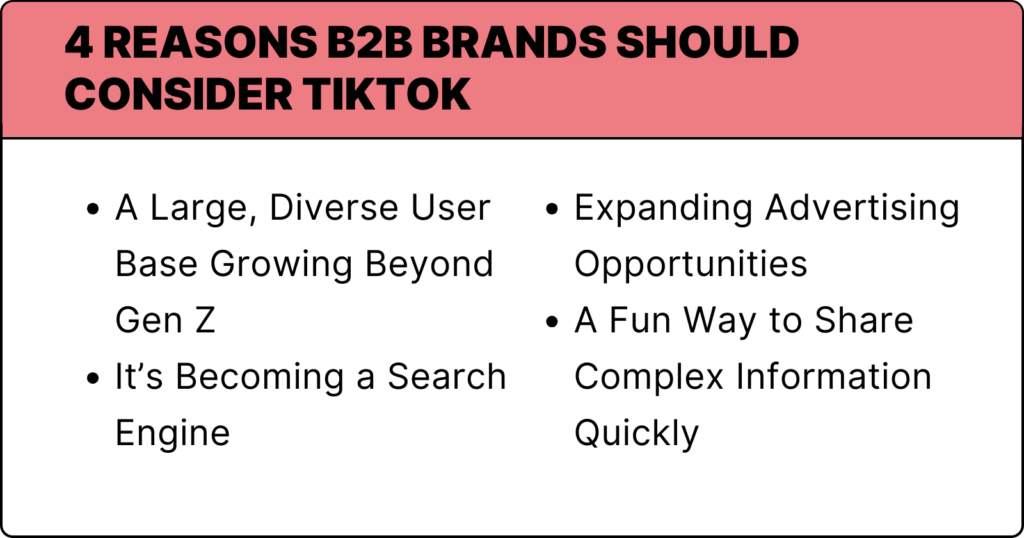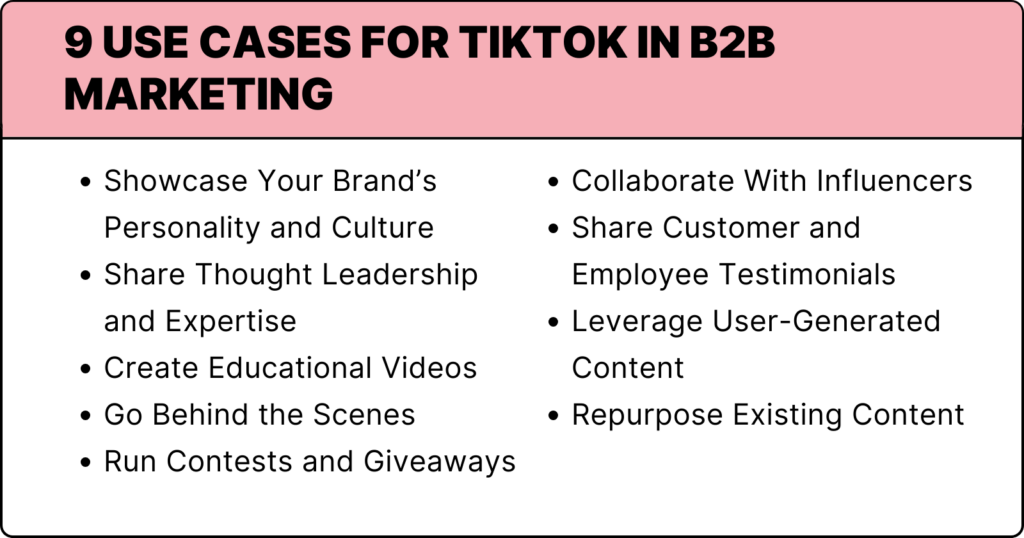TikTok exploded onto the social media scene in 2016 as a platform for short-form videos, with many U.S. users discovering the app a couple of years later when it absorbed Musical.ly. Less than 10 years later, TikTok is a juggernaut that can’t be defined by just one demographic or style of video. If you thought TikTok was just for teens, you’re missing out on a chance to explore B2B TikTok.
Not only that, but TikTok is becoming big business for, well, businesses. The company wants to increase U.S. merchandise sales volume to $17.5 billion in 2024, claiming that the previous holiday season enticed more than 5 million new U.S.-based customers.
Even if you aren’t selling directly on TikTok, creative business-to-business marketers are finding ways to leverage this platform to drive brand awareness, showcase expertise, make meaningful connections and nurture leads.
Learn more about the social platform and how to create your own B2B TikTok marketing strategy.

Why B2B Companies Should Consider TikTok Marketing
Regardless of your brand’s current marketing or social media strategy, there are many reasons why content marketers should consider TikTok.
A Large, Diverse User Base Growing Beyond Gen Z
TikTok’s active user base depends on who you ask and how you parse it. TikTok says 170 million people overall, while Insider Intelligence says 87.3 million if you only count adults. Either way, it’s a massive, highly engaged audience with different demographics than, say, LinkedIn.
While 23% of U.S. users are Generation Z, according to Statista, 55% are millennials or Generation X — in the prime of their careers and likely targets for B2B businesses.
It’s Becoming a Search Engine
Adobe research claims that over 40% of Americans have used TikTok as a search engine at least once. It could even become a competitor to Google, with TikTok encouraging users to put its search engine on their phone’s home screen for easy access.
Additionally, TikTok sells search advertising, offering a direct way for brands to reach engaged users.
Expanding Advertising Opportunities
TikTok offers a variety of advertising opportunities. Including targeted ads, influencer partnerships, and commerce, giving businesses multiple ways to reach their desired audience.
For example, TikTok offers lead generation capabilities through its advertising feature. The platform also offers various creator services, including a marketplace.
A Fun Way to Share Complex Information Quickly
TikTok’s short-form, music-heavy video format presents an ideal opportunity for B2B businesses to convey complex information concisely and with flair. Businesses can quickly and effectively share product demonstrations, industry insights, company culture and more — distilling what might otherwise be a lengthy demo or blog post into a quick viewing for busy professionals.

9 Use Cases for B2B TikTok Marketing
Just as there are many reasons to consider TikTok, B2B brands can use the platform in many ways to accomplish their marketing goals.
Showcase Your Brand’s Personality
TikTok is particularly trusted by younger users, and active brands can create authentic connections with these audiences while showcasing not only their products but also their value, mission and point of view
Shopify, for example, shares e-commerce tips and inspirational stories, subtly showcasing its platform’s capabilities. Canva mixes design tutorials with relatable content that appeals to its target audience of marketers and creators. Adobe, meanwhile, posts creative skits that aren’t afraid to poke fun at its products.
Share Thought Leadership and Expertise
Just as blog posts and white papers can deliver B2B thought leadership, so can TikTok. Bizzuka CEO John Munsell uses his TikTok account to teach people how to use generative AI for marketing.
“Our strategy involves creating captivating short videos that introduce unique AI techniques and concepts that you won’t see anywhere else,” Munsell says. “We then funnel viewers toward our bimonthly CXO AI Roundtable where they can see the full, in-depth discussions we have on AI in business.”
Create Educational Videos
TikTok is a perfect platform for sharing short, educational videos to help your target audience learn about your products or services. For example, you might demo one of your products, show a quick sound bite from an executive or industry expert, or create a time-lapse video of how your products are used.
Go Behind the Scenes
Behind-the-scenes footage is a great way to give your audience a glimpse into your company culture and the people who work there. This tactic can build trust and rapport with your audience and make them more likely to do business with you.
For example, you could share videos of your employees working on projects or take your audience on a tour of your office. Share behind-the-scenes looks at team-building events and community activities or daily office life. (Perhaps create your own version of “The Office” to share in serial videos.)
All of these things create a connection with your audience and help them embrace your people, not just your brand.
Run Contests and Giveaways
Contests and giveaways generate excitement and engagement on TikTok. You can run contests for charitable causes, free products or services, gift cards, a chance to meet with your team and much more.
Hashtag challenges are one of the most effective TikTok contests. Users can create their own version of the original video and tag it using the same hashtag. Make your hashtag catchy, to garner interest while staying relevant to your brand and messaging.
Other contest options include theme-based video contests, trivia and Q&A.
Collaborate with Industry Influencers
If you market on X (formerly Twitter), Instagram or YouTube, you might already be experienced with influencer partnerships. TikTok is a powerful opportunity to connect with influencers, whether they’re experts in your field or simply enthusiasts.
Think outside the box with TikTok influencers, but make sure their values and activities align with your brand values. Because people trust their recommendations, an influencer’s stamp of approval can be more authentic and effective than any traditional advertisement.
One example of this is Zendesk, which partnered with Jax (nearly 14 million followers) for an original song on Zendesk’s TikTok.
Share Customer and Employee Testimonials
Testimonials are a powerful way to get new business whether you’re online or offline. TikTok lets you showcase these customer or employee endorsements in new ways, humanizing your brand. You can burnish your reputation and build trust with your audience in ways that ads can’t deliver.
For customer testimonials, focus on how your product or service has solved a unique problem or delivered exceptional value. For employee testimonials, highlight the people behind your brand, their roles and their passion for what they do.
This can also be an excellent opportunity to showcase your company’s diversity, equity and inclusion efforts.
Leverage User-Generated Content
TikTok’s user-generated content (UGC) model offers a powerful way for B2B marketers to engage with their audience. Businesses can foster community by encouraging customers and industry influencers to create content related to their products or services.
Alternatively, your brand can hop on to popular hashtags and contribute your own content. Just make sure the hashtag meshes with your brand’s values and image — and that you don’t come across like you’re trying to take over the hashtag or trend.
Repurpose Existing Content
Repurposing on TikTok is a good way to break down complex topics into bite-sized, easily digestible pieces.
While your brand’s TikTok account might not mirror your other platforms, look at how you can repurpose content — or at least the themes — from your other marketing efforts.
Recut the key points from blog posts into short, captivating videos. Take the best moments from webinars or other long-form video content and transform them into engaging short-form videos. Make these clips suitable for TikTok by using captions, effects and music.
TikTok Business vs. Creator Accounts
Brands can use TikTok in two ways: Business and Creator accounts. The main differences between a TikTok business account and a creator account are as follows:
TikTok Business Account
A TikTok business account is intended for use by, you guessed it, businesses. It includes features such as a full analytics suite, access to advertising tools and messaging capabilities. Brands can also add an external link to their bio and integrate with third-party tools for social media marketing.
According to TikTok’s business help page, business accounts can also:
- Collect leads with flexible forms on your profile, videos and LIVE Events.
- Showcase business info and drive traffic to your website or app.
- Find content inspiration and industry trends in Business Suite.
- Schedule TikTok posts up to 10 days in advance.
- Access over 1 million songs and sounds for commercial use.
TikTok Creator Account
A TikTok creator account is for personal use by any users, not just influencers, organizations or public figures. It’s the default account type.
Creator accounts feature limited analytics and monetization opportunities compared with business accounts. Creators can only communicate with people on their friend list, and profiles can’t have an external link until the account has at least 1,000 followers.
Creating an Effective B2B Marketing Strategy on TikTok
The secret to B2B TikTok marketing and content marketing is much like any other channel: a combination of sound marketing strategy and deep knowledge of what works on the platform.
Understand TikTok’s Environment
Familiarize yourself with TikTok’s culture and features to create content that resonates with viewers.
TikTok stands out from other social media platforms due to its focus on short-form, viral video content, integrated music and soundtracks, and a highly effective recommendation system.
Its culture thrives on trends, creativity and the power of the “For You” feed. B2B marketers must embrace its preferred content formats and actively engage with the platform.
Determine the Fit With Your Brand
You need to ask two important questions: Is your audience there, and can you create suitable content?
Dig into your audience demographics. If you’re targeting young entrepreneurs, companies in nascent industries or other younger business buyers (Gen Z and Millennials), TikTok is probably a smart choice. But it’s not like Gen X and boomers are absent. In fact, those older working-age demographics might be less targeted by B2B brands and thus easier for you to reach.
TikTok content creation has its own demands, even if you do some repurposing from other video content. Determine whether you have the resources and/or the capability to create content that resonates with these users. Professional services firms, for instance, might struggle to find a content niche that feels right, but it’s still worth investigating.
Get Internal Buy-In
If you’re seeking budget for adding TikTok as a marketing channel, stakeholder buy-in is crucial. Be ready to demonstrate TikTok’s unique value and potential ROI. Share success stories from brands in your industry. Highlight TikTok’s rapidly growing user base and its effectiveness in reaching younger demographics.
Further, explain how you’ll repurpose content and campaign themes through TikTok, making it more resource-efficient. If you still face resistance, propose a pilot campaign with measurable objectives to showcase the platform’s potential with minimal risk.
Set Up a Business Account
New TikTok users start with a creator account, but just as with any other social network, it’s best to set up a business account to take advantage of all the perks, including advertising.
Develop a Content Strategy
Developing a strategic approach to content creation can make the difference between high-traffic, high-engagement videos and crickets. Remember that the principles of great content calendars still apply.
Take advantage of TikTok’s platform features to create a mix of trending topics and original content, such as product demos and behind-the-scenes stories. Don’t be afraid to try things as long as they make sense for the brand. If you’re looking to highlight your employees or your new production facility, worry less about how polished your video is and more about it being authentic and inviting. If you’re showing a product demo, of course, put the product in the best light possible.
For brands also csimilar content on Instagram or YouTube, look to repurpose it on TikTok and vice versa, even if you make slight adjustments for each channel. Similarly, if you work with influencers, see what platforms they’re open to collaborating with you on.
Stay Up to Date
The TikTok ecosystem changes rapidly, and what worked six months ago may be old hat today. Watch out for trending content, trendsetters and emerging creators using TikTok’s Discover page and engaging with the TikTok community.
Key Metrics to Measure B2B Success on TikTok
TikTok isn’t just about views or likes. It’s about engagement — are people commenting, sharing or using your hashtags? Like any other social network, TikTok has key analytics worth tracking:
Creator Metrics
These basic TikTok metrics are available to any creator, not just business accounts.
- Overview: This tab lists such data as follower growth, video and profile views, number of likes, comments and shares over multiple time periods. This tab lets you explore up to 60 days’ worth of data in a high-level view.
- Content: This tab shows data by individual video — metrics from the Overview tab along with average watch time, the percentage of viewers who completed the video, and various traffic-source metrics. This tab only tracks the past seven days, however.
- Followers: This tab is a deeper dive into your audience, including their location, when they are most active and trends in follower growth. You can view this data over seven- and 28-day periods.
Advertising Metrics
These TikTok advertising metrics can help you understand how your paid content is performing. They include common metrics such as clicks, conversions, reach and CPM rates. TikTok has attribution metrics for many of these data points, such as cost per CTA conversion and cost per CTA purchase.
There are numerous other metrics available, as well as the ability to create reports.
Embrace TikTok for B2B Marketing
Remember, TikTok isn’t LinkedIn, but that doesn’t mean it’s not a valuable place to show off your brand and even find new customers. Remember that TikTok values authenticity over polish, consistency over infrequent posting, and engagement with trends without sounding insincere.
B2B TikTok might not generate immediate results, but that’s why you want to build it out as part of your overall marketing strategy. Treat TikTok as a long play to gradually build awareness and relationships with prospective and current customers. Keep providing value and having fun, and the ROI will come.
Want more advice like this on trends in content marketing? Sign up for our weekly LinkedIn newsletter!






